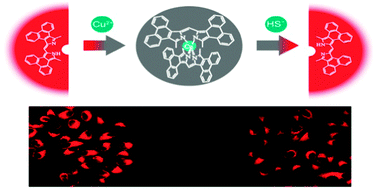A red fluorescent turn-on probe for hydrogen sulfide and its application in living cells†
Abstract
A novel selective fluorescent chemosensor 1 has been synthesized with a

* Corresponding authors
a
State Key Laboratory of Coordination Chemistry, Nanjing University, Nanjing 210093, P. R. China
E-mail:
zshen@nju.edu.cn
Fax: +86 (0)25-83314502
Tel: +86 (0)25-83686679
b Department of Chemistry, Rhodes University, Grahamstown 6140, South Africa
A novel selective fluorescent chemosensor 1 has been synthesized with a

 Please wait while we load your content...
Something went wrong. Try again?
Please wait while we load your content...
Something went wrong. Try again?
X. Qu, C. Li, H. Chen, J. Mack, Z. Guo and Z. Shen, Chem. Commun., 2013, 49, 7510 DOI: 10.1039/C3CC44128H
To request permission to reproduce material from this article, please go to the Copyright Clearance Center request page.
If you are an author contributing to an RSC publication, you do not need to request permission provided correct acknowledgement is given.
If you are the author of this article, you do not need to request permission to reproduce figures and diagrams provided correct acknowledgement is given. If you want to reproduce the whole article in a third-party publication (excluding your thesis/dissertation for which permission is not required) please go to the Copyright Clearance Center request page.
Read more about how to correctly acknowledge RSC content.
 Fetching data from CrossRef.
Fetching data from CrossRef.
This may take some time to load.
Loading related content
